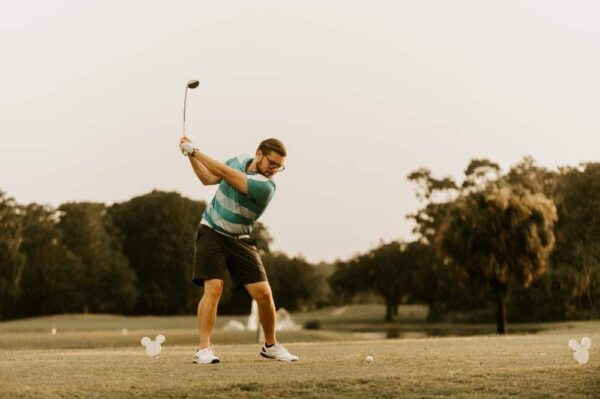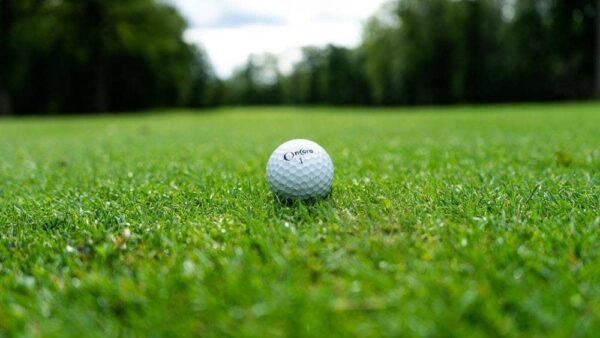5 Myths About the Golf Swing
Wait a minute…you’re telling me everything I’ve learned is WRONG?
When it comes to golf, there are plenty of players who are quick to give advice.
Unless that advice has been given to you by an experienced coach or PGA pro, take it with a grain of salt.
Golf swing myths are common.
So common, that you’ve probably heard quite a few of these or have even contributed to their spread (with good intentions, of course).
Not only are these myths hurting your game, but they could be hurting YOU!
Our physical therapists at Back in Motion Physical Therapy & Performance in Fort Myers, Florida, have seen numerous golfers come in with injuries caused by following a golf swing myth.
Some of the myths include altering your natural swing posture, which frequently results in injury (and no benefits to your swing).
So, hopefully not everything you’ve learned is wrong; but if you’re guilty of one (or more) of these golf swing myths, it’s time to make a change:
#1: “The Bigger, The Better”
Let’s start with the golf swing myth that is responsible for many-an-injured golfer showing up to our sports physical therapy clinic.
There is a common misconception that when it comes to your golf swing, the bigger the swing = the better.
It’s understandable why this myth is so common. After all, we do see many of the pros taking big, full swings.
While a pro may boast a big swing, it’s probably going to do the average golfer more harm than good.
Photo by sydney Rae on Unsplash
If you’re not well conditioned in golf (or if you lack any flexibility), trying for the biggest swing you can make will only hurt your golf performance and your spine.
Taking too large of a swing can throw off your coordination and hinder your posture.
Instead of adopting “the bigger, the better” mindset, focus on starting your swing from the ground up.
Your lower body should start the forward swing movement while your club, hands, and arms simultaneously move towards the top of the swing.
Do you have an achy back or lack of control in your swing? It’s time to cut out “the bigger the better” golf swing myth and see an improvement both in your swing and your spine.
#2: “Slow Down!”
Photo by Javier Mazzeo on Unsplash
If your swing’s a little lackluster, you might feel that slowing down is the answer.
It makes sense: we want to slow down to concentrate on “getting it right.”
But the “slow down” myth needs to slow down itself…and then disappear, forever.
That’s because this myth doesn’t produce a better swing: it simply produces the same swing…just slower.
Do you ever enjoy hearing that “swoosh” sound on the T.V. as your favorite golfer hits a tee shot? That satisfying swoosh is only made possible by speed.
More speed means more power. Slowing down won’t lead to a better swing – just a weaker one.
To hit the ball at a fast speed with good technique, it’s important to perform golfing warmup exercises before practicing your swings.
Exercises such as arm circles, trunk rotations, and dynamic stretching will help you gain the flexibility and balance needed for a great, fast swing.
Cut out some extra time each week to practice strengthening exercises such as lunges and Olympic lifts. These exercises will increase your power, speed, balance, coordination, and posture – all of which will help you avoid slow, choppy swings.
#3: “Keep Your Head Still (and Down)!”
Photo by Courtney Cook on Unsplash
This myth is so common that nearly every golfer has heard it at some point.
When golfers come into our sports physical therapy clinic with neck soreness or injury, you can almost guarantee that they were following this popular myth.
If you’re having trouble controlling the swing, it’s natural to assume that it’s because of your head placement.
However, it’s very unlikely that your head will move up too early during a swing.
The motion of a swing is so fast, and your head (weighing in between 8 and 12 pounds) is so heavy, that lifting up your head before or upon impact would take a great amount of effort.
Therefore, lifting your head up “too early” is probably not the issue if you’re having trouble with your swing.
On the contrary, concentrating on keeping your head still and down WILL cause trouble with your swing.
Locking your head into position will limit the follow-up motion after impact. Your posture will get restricted, limiting your ability to achieve a full, powerful swing.
In fact, concentrating on keeping the head down and straight is one of the most common causes of a bent left arm upon impact, which leads us to our next myth…
https://backinmotionsspt.com/wp-content/uploads/2020/05/SPORTS-INJURIES_3D-600×600.png
GET YOUR FREE REPORT
Free Report Reveals … A Step-By-Step Guide To Overcoming 7 of the Most Common Injuries Suffered By Athletes & Weekend Warriors
PGEgY2xhc3M9Im9wdGltaXplLWxlYWRzLWxpbmstdHJpZ2dlciBvcHRpbWl6ZS1sZWFkcy10YWctYnV0dG9uIiBocmVmPSJodHRwczovL215Lm9wdGltaXplbGVhZHMuY29tL3B1YmxpYy9aTWpMT05qTTJlNTkiIHRhcmdldD0iX2JsYW5rIiBzdHlsZT0iZGlzcGxheTogZmxleDsganVzdGlmeS1jb250ZW50OiBjZW50ZXI7IGlubGluZS1ibG9jazsgcGFkZGluZzogMWVtIDJlbTsgZm9udC13ZWlnaHQ6IG5vcm1hbDsgdGV4dC1kZWNvcmF0aW9uOiBub25lOyBib3JkZXI6IDAgbm9uZTsgZm9udC13ZWlnaHQ6IG5vcm1hbDsgYmFja2dyb3VuZC1jb2xvcjogI2U3NTYwYTsgY29sb3I6ICNmZmZmZmY7IGJvcmRlci1yYWRpdXM6IDhweDsgYm94LXNoYWRvdzogcmdiYSgwLCAwLCAwLCAwLjUpIDAgMCAwcHggMDsiIGRhdGEtb3B0aW1pemUtbGVhZHMtdWlkPSJaTWpMT05qTTJlNTkiPkdldCBZb3VyIEZyZWUgR3VpZGU8L2E+PHNjcmlwdCB0eXBlPSJ0ZXh0L2phdmFzY3JpcHQiIHNyYz0iaHR0cHM6Ly9vcC1sZWFkcy1hc3NldHMuczMuYW1hem9uYXdzLmNvbS9hc3NldHMvanMvbGVhZHMuanMiIGRhdGEtb3B0aW1pemUtbGVhZHMtdWlkPSJaTWpMT05qTTJlNTkiIGFzeW5jPjwvc2NyaXB0Pg==
#4: “Lock that Left Arm!”
Photo by Samantha Gades on Unsplash
We get the logic – having a straight left arm while swinging usually generates more power than a left arm that is totally bent.
But a left arm that is locked in straight? This will only cause tension and tightness in your swing.
If you’re finding that your swing is weak and your left arm is always bent, don’t focus on keeping your left arm completely straight.
Instead, focus on keeping your left arm relaxed, avoid locking your head in place, and allow your swing to move as far as you can without compromising your posture to swing larger.
Perhaps your left arm won’t look totally straight – and that’s okay! It’s a lot better than stiffening the left arm to keep it straight, which will inevitably lead to stiff shoulders, a stiff neck, and a restricted swing.
P.S. – there’s proof that you can get away with a bent left arm. Just look at professional golfers like Kenny Perry, Jordan Spieth, and Calvin Peete.
Working with your own flexibility will bring much more success than focusing on certain “rules” such as keeping a straight left arm or a still head.
#5: “Roll the Wrists Through Impact”
“Impact” lasts less than a fraction of a second…so trying to “roll the wrists through impact” is a sure-fire way to overcomplicate things.
Trying to achieve this wrist movement is such a small detail that you’ll probably leave out the “big picture” and sacrifice more important aspects of the swing to obtain this little movement.
To square up the club through impact, it’s all about how you hold your club – not how you move your wrists.
If you hold your club firmly, but not too tightly, your wrists will naturally roll through impact.
A Better Way to Play
Photo by Peter Drew on Unsplash
Once you cut out these myths, you should start to see a significant improvement in your swing.
The best way to perfect your golf swing doesn’t include focusing on the small details…it involves a big-picture approach, such as:
- Rotating your upper back
- Turning your hips
- Improving your balance
- Strengthening your core
- Improving your dissociation (by separating the movements of your trunk and your pelvis)
Focusing on the big-picture elements of the swing will allow you to have more control and hit the ball further.
How to Enjoy Pain-Free Play
Playing golf with pain or stiffness will prevent you from reaching your full potential and can lead to more serious injuries.
Call our office at 866-946-9539 and schedule your appointment today!
We offer Physical Therapy in Fort Myers, FL, and Physical Therapy in Cape Coral, FL.
Our physical therapy team has worked with golfers of all levels (including PGA pros!) to get them back in the game, pain-free.
Unlike the many ineffective symptom-based treatments out there, we take a cause-based approach to fix the root cause of your problem.
The result?
Permanent relief from your pain/stiffness and a dramatically improved golf game!
Want to See How We Can Help You?
Claim A Free 30 Minute Discovery Visit….
Click Here to Request Your Free Discovery Session








